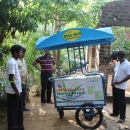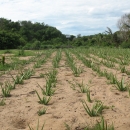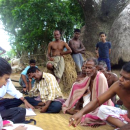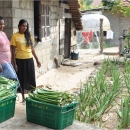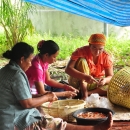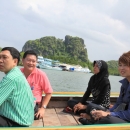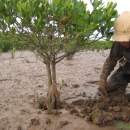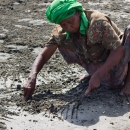Strengthening the Empowerment Process
Case studies featuring MFF interventions that empower stakeholders to engage in decision-making that supports sustainable management of coastal ecosystems
Location: Asia Region.
In terms of strengthening the stakeholder empowerment process, MFF builds capacity and understanding that enables genuine multi-stakeholder engagement wherein people and institutions can sustainably manage coastal ecosystems. Through MFF’s grant facility, MFF has been able to effectively demonstrate a number of successful management models and approaches that empower stakeholders in coastal management decision making processes. MFF’s interventions include support to restoration and management of ecological services in degraded coastal habitat areas; development of supplementary livelihood opportunities that contribute to reduce threats to biodiversity; and building of capacity through the social empowerment process (education, awareness raising, leadership and organizational development, etc.) for collective action in community based management and/or co-management. Ultimately, results from MFF projects contribute to the creation of an enabling policy environment.
What follows are case studies that illustrate how MFF projects strengthen empowerment.
“Sustainable use of mangrove resources to benefit poor women through a co-management pilot in the core zone of Xuan Thuy National Park, Vietnam” (Nam Dinh, Viet Nam)
This project demonstrates an approach that highlights the social empowerment process by creating an enabling policy environment. Key stakeholders (especially coastal women) participated in decision-making that supported sustainable management of coastal ecosystems.
A Small Grant Facility project in Viet Nam introduced a co-management regime in the Xuan Thuy National Park to enable fishing groups that live in the buffer zone to exploit resources in the core zone. The progress of this venture has been successful in that in addition to fishing within the core zone of the Park, they are now involved in decision-making. Twenty five fisher women have been granted loans to undertake alternative livelihoods. Whilst the household income has increased, the experiences from this national park has prompted the Government to issue a Prime Ministerial Decision (126) to further pilot benefit sharing in the management of the Park. As a result, 500 fisherwomen are now registered, and are allowed to exploit the resources under the oversight of a 15-person committee that includes representatives from the Park, local authorities, and communities. The fisherwomen have increased income by about USD 25 per month. Through peer monitoring, damage by unsustainable collecting practices has been reduced. The Park has now proposed that each collector pays USD 2.50 per month to a livelihood fund, which will also be used to provide loans for further livelihood improvement work. The Project has facilitated the recognition of the fisherwomen in the buffer zone management, and with the progress made over the last two year; there has been a significant shift by the Park authorities in the last 12 months to accept them for resource utilization.
“Community stewardship in conservation, restoration and sustainable management of mangroves, Orissa” (Orissa, India)
This project demonstrates how women members of a local village council decision making body are active in disaster resilience planning, and how their participation enhances coastal governance policy that promotes integrated and inclusive management.
A Small Grant Facility project in Orissa restored over 12 ha of mangroves on community-owned land in ten villages. The process was led by 16 women members of a community organisation in Basantpur village. This marked the first time in Basantpur village that women members volunteered to give their time to participate in decision-making meetings and restoration of mangrove areas. The women continue to monitor and protect the restored area. The women became members of the Village Mangrove Councils (VMC), and were enlisted to join various decision-making bodies including the Disaster Resilience Committee, which specifically deals with disaster preparedness. One of the first initiatives that the VMC supported was the development of local vegetable gardens for supplementary livelihood. Towards the end of the project, several families reported an average 10% increase in their monthly income from selling vegetables. Families felt they had increased food security.
“Empowering fisherwomen by generating additional income from cultivation of Aloe vera: Alternative income generation for fisherwomen” Kalpitiya, Sri Lanka
This project demonstrates the use of supplemental livelihood development to provide alternative income generation for communities reliant on overfished fisheries and its potential for reducing overall fishing effort.
In MFF Phase 1, a grant of USD 5,000 was provided to a local NGO that was interested in introducing Aloe vera cultivation in homesteads of fishers by women in Kalpitiya, Sri Lanka. The NGO provided technical know-how and also arranged the sale of Aloe vera to a cosmetic company in Colombo, who decided to buy the entire production from the fisher village thereby stopping collection from the wild. This venture increased household income by 26%, and fishermen have also joined in this pursuit leading to a potential reduction in fishing effort. The cosmetics company buys the aloe vera and now has a regular supply of raw material, so wild collection has stopped, thus contributing to biodiversity conservation as well. As a result of the success, other fishers also replicated the efforts, increasing the production of Aloe vera in Kalpitiya. During the last year, the same NGO was awarded a further small grant resulting in the introduction of an Aloe vera drink with the surplus Aloe vera. From 31 January 2013, the daily production of the beverage has been around 25 liters, which is now sold in the nearby township. The additional income has been about USD 100 per month, which is a substantial increase. Furthermore, Aloe vera cultivation has been introduced to other parts of the country where fishers are struggling with overfishing etc. The replication of this venture within the last 15 months has been significant, and sustainable.
"Ecosystem-based integrated coastal resource management through multi-stakeholder participation in Southern Thailand" (Trang and Nakhon Sri Thammarat, Thailand)
This project demonstrates how multiple issues of coastal resource depletion and natural disaster impacts on local communities were addressed by introducing ecosystem-based integrated coastal resource management through multi-stakeholder participation, knowledge management, and capacity building for actors and stakeholders. The aim was to link policy makers and coastal communities in their efforts to improve ecosystem management and disaster preparedness. The project was implemented in two provinces in Thailand, Trang and Nakhon Sri Thammarat and focused on developing community-based coastal environment management (CBCEM) plans. The main activity was focused on ecosystem rehabilitation, conservation and protection achieved through multi-stakeholder collaboration in the implementation of the CBCEM plan. This project enabled traditional rights holders and duty bearers to more effectively engage and agree on the use of coastal resources. The project also emphasizes the importance of developing the capacity of marginalized groups to define and implement collective action. The project effectively addressed asymmetries of power, and established a collaborative governance process through which people can negotiate, claim rights and meet responsibilities.
Trang
In the villages of Modtanoi and Namrab, the project found that coastal communities were more likely and more willing to invest their time and resources in coastal ecosystem protection, conservation, rehabilitation and management when they are aware of and understand the wide range of benefits they receive. These benefits may be in terms of important ecosystem services such as natural disaster and hazard mitigation, or livelihood support (such as crab banks). In Namrab’s case, the CBCEM plan addressed the problem of illegal fishing gears. Another activity was the rehabilitation of ten rai of mangrove forests. In terms of livelihood security, the CBCEM plan supported local regulations that protected wing shell harvesting in Modtanoi and crab banking in Namrab.
All activities were managed with the collaboration with the TAO; Office of the Provincial Governor; Coastal Resource Conservation Center Trang; and the Office of Natural Resources and Environment Trang. Through the collaborative process established by SDF, villagers became more enthusiastic in implementing activities related to ecosystem rehabilitation, conservation and protection.
Nakhon Sri Thammarat
The project successfully facilitated a change in approach to conservation efforts and disaster response efforts: from isolated, agency-led activities, the project introduced integrated, multi-stakeholder interventions that encouraged innovation and collaboration. Four villages in Tasala sub-district rehabilitated at least 800 rai of mangroves. In terms of developing disaster mitigation and climate change adaptation plans, Nah Tab and Naitung implemented the use of community radio as a disaster response activity.
![[Trang & NakornSrithammart] 2nd MLE to SDF Project](/assets/Repository/Images/_resampled/sidebarW10/2-10.11-Trang-NakornSrithammart-2nd-MLE-to-SDF-Project.JPG)
